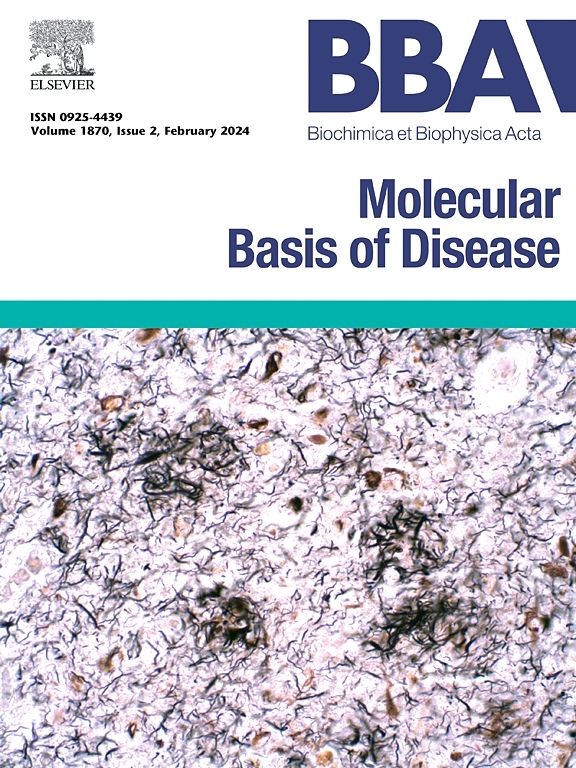TSPO participates in the pathogenesis of diabetic periodontitis related to mitophagy
IF 4.2
2区 生物学
Q2 BIOCHEMISTRY & MOLECULAR BIOLOGY
Biochimica et biophysica acta. Molecular basis of disease
Pub Date : 2025-04-23
DOI:10.1016/j.bbadis.2025.167866
引用次数: 0
Abstract
Objectives
Diabetic periodontitis (DP) appears to be the sixth most common complication of diabetes; however, its underlying pathological mechanisms require further explored. Our study investigated the potential function of the translocator protein (TSPO) in the progression of DP, aiming to provide a theoretical foundation for novel treatment strategies.
Methods
The ultrastructure and TSPO expression of gingival tissue, collected from healthy individuals, people with periodontitis, and those with DP, were examined. In vivo, a DP model in rats was established using streptozotocin (STZ) and silk ligation. TSPO ligand antagonist PK 11195 was administered as a treatment. Microcomputed tomography (Micro-CT), quantitative real-time polymerase chain reaction (qPCR), histology and immunohistochemistry were employed to assess the destruction, inflammatory and mitophagy in rat periodontal tissues. In in vitro experiments, the inflammatory responses, mitochondrial function, mitophagy and the potential role of TSPO in macrophages were also examined under high-glucose inflammatory conditions, using flow cytometry, fluorescence probes, qPCR, Western blotting and transcription inhibition.
Results
Mitochondrial damage, mitophagy inhibition and increased TSPO expression were observed in gingivae from patients with DP. PK 11195 facilitated the restoration of mitophagy and alleviated the inflammatory destruction of DP rats. Additionally, the high-glucose inflammatory environment intensified the macrophage inflammatory response, ROS production, and mitochondrial damage. These pathological changes were reduced by TSPO inhibition, which could also upregulate the mitophagy.
Conclusions
The inflammation and destruction of periodontal tissue in DP are closely linked to mitophagy associated with TSPO. Immunotherapy targeting TSPO in macrophages could significantly influence the treatment of DP by modulating mitophagy.
TSPO参与了与线粒体自噬相关的糖尿病牙周炎的发病机制
目的:糖尿病牙周炎(DP)是糖尿病的第六大常见并发症;但其潜在的病理机制有待进一步探讨。本研究旨在探讨转运蛋白(TSPO)在DP进展中的潜在功能,为新的治疗策略提供理论基础。方法对健康人、牙周炎患者和DP患者的牙龈组织进行超微结构和TSPO表达的检测。在体内,采用链脲佐菌素(STZ)和丝结扎法建立大鼠DP模型。给予TSPO配体拮抗剂PK 11195作为治疗。采用显微计算机断层扫描(Micro-CT)、定量实时聚合酶链反应(qPCR)、组织学和免疫组织化学方法评估大鼠牙周组织的破坏、炎症和有丝分裂。在体外实验中,采用流式细胞术、荧光探针、qPCR、Western blotting和转录抑制等方法,研究了高糖炎症条件下巨噬细胞的炎症反应、线粒体功能、线粒体自噬和TSPO的潜在作用。结果DP患者牙龈出现线粒体损伤、线粒体自噬抑制和TSPO表达升高。PK 11195促进DP大鼠线粒体自噬恢复,减轻炎症破坏。此外,高糖炎症环境加剧了巨噬细胞的炎症反应、ROS的产生和线粒体损伤。抑制TSPO可减轻这些病理变化,并可上调线粒体自噬。结论DP患者牙周组织的炎症和破坏与TSPO相关的自噬密切相关。针对巨噬细胞TSPO的免疫治疗可以通过调节线粒体自噬来显著影响DP的治疗。
本文章由计算机程序翻译,如有差异,请以英文原文为准。
求助全文
约1分钟内获得全文
求助全文
来源期刊
CiteScore
12.30
自引率
0.00%
发文量
218
审稿时长
32 days
期刊介绍:
BBA Molecular Basis of Disease addresses the biochemistry and molecular genetics of disease processes and models of human disease. This journal covers aspects of aging, cancer, metabolic-, neurological-, and immunological-based disease. Manuscripts focused on using animal models to elucidate biochemical and mechanistic insight in each of these conditions, are particularly encouraged. Manuscripts should emphasize the underlying mechanisms of disease pathways and provide novel contributions to the understanding and/or treatment of these disorders. Highly descriptive and method development submissions may be declined without full review. The submission of uninvited reviews to BBA - Molecular Basis of Disease is strongly discouraged, and any such uninvited review should be accompanied by a coverletter outlining the compelling reasons why the review should be considered.

 求助内容:
求助内容: 应助结果提醒方式:
应助结果提醒方式:


